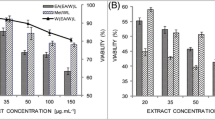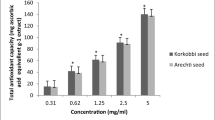Abstract
Jamapa bean is a black Phaseolus vulgaris variety rich in condensed tannins, anthocyanins and flavonols with interesting biological activities. The objective of this work was to evaluate the antiradical capacity (ARC) of a Jamapa bean methanolic extract (BME) and some of the proanthocyanidin-rich fractions derived from it, using the 1,1-diphenyl-2-picrylhydrazyl (DPPH) assay. The effect of the BME on some proteins involved in apoptosis on HeLa cells was also evaluated. A strong correlation between proanthocyanidin concentration in BME and antiradical capacity was found, suggesting that these compounds contribute significantly to antiradical activity. BME was a better radical scavenger than butylated hydroxytoluene (45.6 and 33.9% ARC at 400 µM, respectively). Two proanthocyanidin-rich fractions obtained after a preliminary separation of the BME using Toyopearl (TP4 and TP6) exhibited a higher antiradical activity than the parent extract. The treatment of HeLa cells with 35 µg BME/ml/24 h increased the expression of Bax and Caspase-3, pro-apoptotic proteins (6.13 and 1.2 times for Caspase-3 and Bax, respectively). The mechanism of action of some proteins involved in apoptosis was also evaluated, and the results suggest that black Jamapa bean could be an important source of polyphenolic compounds with potential biological use as antioxidant and anticancer agents.

Similar content being viewed by others
Abbreviations
- ARC:
-
Antiradical capacity
- BHT:
-
Butylated hydroxytoluene
- BME:
-
Bean methanolic extract
- DPPH:
-
1,1-diphenyl-2-picrylhydrazyl
References
Chen Ch, Kong AT (2005) Dietary cancer-chemopreventive compounds: from signaling and gene expression to pharmacological effects. Trends Pharmacol Sci 26(6):318–326
Adams SM, Standridge JB (2006) What should we eat? Evidence from observational studies. South Med J 99(7):744–748
Fernández E, Gallus S, La Vecchia C (2006) Nutrition and cancer risk: an overview. J Br Menopause Soc 12(4):139–142
Barnard RJ (2004) Prevention of cancer through lifestyle changes. Evid Based Complement Alternat Med 1(3):233–239
Liu RH (2003) Health benefits of fruits and vegetables are from additive and synergistic combination of phytochemicals. Am J Clin Nutr 78:517S–520S
Liu RH (2004) Potential synergy of phytochemicals in cancer prevention: mechanism of action. J Nutr 134:3479–3485
Wildman REC (2001) Classifying nutraceuticals. In: Wildman REC (ed) Handbook of nutraceuticals and functional foods. CRC Press, Boca Raton, FL (pp 13–30)
Havsteen BH (2002) The biochemistry and medical significance of the flavonoids. Pharmacol Ther 96(2–3):67–202
Serrano J, Goni I (2004) Role of black bean (Phaseolus vulgaris) on the nutritional status of Guatemalan population. Arch Latinoam Nutr 54(1):36–44
Beninger CW, Hosfield GL (2003) Antioxidant activity of extracts, condensed tannin fractions, and pure flavonoids from Phaseolus vulgaris L. seed coat color genotypes. J Agric Food Chem 51:7879–7883
De Mejia EG, Del Carmen Valadez-Vega M, Reynoso-Camacho R, Loarca-Pina G (2005) Tannins, trypsin inhibitors and lectin cytotoxicity in tepari (Phaseolus acutifolius) and common (Phaseolus vulgaris) beans. Plant Foods Hum Nutr 60(3):137–145
Aparicio-Fernandez X, Yousef GG, Loarca-Pina G, de Mejia E, Lila MA (2005a) Characterization of polyphenolics in the seed coat of black Jamapa bean (Phaseolus vulgaris L.). J Agric Food Chem 53:4615–4622
González de Mejía E, Castaño-Tostado E, Loarca-Piña G (1999) Antimutagenic effects of natural phenolic compounds in beans. Mut Res Genet Toxicol Environ Mutagen 441(1):1–9
Cardador-Martínez A, Castaño-Tostado E, Loarca-Piña G (2002a) Antimutagenic activity of natural phenolic compounds present in common bean (Phaseolus vulgaris L.) against Aflatoxin B1. Food Addit Contam 19:62–69
Oomah BD, Cardador-Martínez A, Loarca-Pina G (2005) Phenolics and antioxidative activities in common beans (Phaseolus vulgaris L.). J Sci Food Agric 85:935–942
Galvez-Ranilla L, Genovese MI, Lajolo FM (2007) Polyphenols and antioxidant capacity of seed coat and cotyledon from Brazilian and Peruvian bean cultivars (Phaseolus vulgaris L.). J Agric Food Chem 55:90–98
Bawadi HA, Bansode RR, Trappey IIA, Truax RE, Losso JN (2005) Inhibition of Caco-2 colon, MCF-7 and Hs578T breast, and DU 145 prostatic cancer cell proliferation by water-soluble black bean condensed tannins. Cancer Lett 218:153–162
Aparicio-Fernandez X, García-Gasca T, Yousef GG, Lila MA, de Mejia E, Loarca-Pina G (2006) Chemopreventive activity of polyphenolics from black Jamapa bean (Phaseolus vulgaris L.) on HeLa and HaCaT cells. J Agric Food Chem 54:2116–2122
Dong M, He X, Liu RH (2007) Phytochemicals of black bean seed coats: isolation, structure elucidation, and their antiproliferative and antioxidative activities. J Agric Food Chem 55:6044–6051
Aparicio-Fernandez X, Manzo-Bonilla L, Loarca-Piña G (2005b) Comparison of antimutagenic activity of phenolic compounds in newly harvested and stored common beans Phaseolus vulgaris against aflatoxin B1. J Food Sci 70:S73–S78
Shankar S, Ganapathy S, Srivastava RK (2007) Green tea polyphenols: biology and therapeutic implications in cancer. Front Biosci 12:4884–4899
Fang J, Nakamura H, Iyer AK (2007) Tumor-targeted induction of oxystress for cancer therapy. J Drug Target 15:475–486
Galati G, O’Brien PJ (2004) Potential toxicity of flavonoids and other dietary phenolics: significance for their chemopreventive and anticancer properties. Free Radic Biol Med 37(3):287–303
Deshpande SS, Cheryan M (1985) Evaluation of vanillin assay for tannin analysis of dry beans. J Food Sci 50:905–910
Deshpande SS, Cheryan M (1987) Determination of phenolic compounds of dry beans using vanillin, redox and precipitation assays. J Food Sci 52(2):332–334
Fukumoto LR, Mazza G (2000) Assessing antioxidant and prooxidant activities of phenolic compounds. J Agric Food Chem 48:3597–3604
Cardador-Martínez A, Loarca-Piña G, Oomah BD (2002b) Antioxidant activity in common beans (Phaseolus vulgaris L.). J Agric Food Chem 50:6975–6980
Burda S, Oleszek W (2001) Antioxidant and antiradical activities of flavonoids. J Agric Food Chem 49:2774–2779
Lowry OH, Rosenbrough JN, Fan A, Randall RJ (1951) Protein measurement with folin phenol reagent. J Biol Chem 193:265–275
SAS Institute (1999) SAS user’s guide: Statistics, 8th edn. SAS Institute, Cary NC
Heimler D, Vognolini P, Dini MG, Romani A (2005) Rapid tests to assess the antioxidant activity of Phaseolus vulgaris L. dry beans. J Agric Food Chem 53:3053–3056
Troszyńska A, Ciska E (2002) Phenolic compounds of seed coats of white and coloured varieties of pea (Pisum sativum L.) and their total antioxidant activity. Czech J Food Sci 20:15–22
Kundu T, Dey D, Roy M, Siddiqi M, Bhattacharya RK (2005) Induction of apoptosis in human leukemia cells by black tea and its polyphenol theaflavin. Cancer Lett 230:111–121
Roy AM, Baliga MS, Elmets CA, Katiyar SK (2005) Grape seed proanthocyanidins induce apoptosis through p53, Bax, and Caspase 3 pathways. Neoplasia 7(1):24–36
Antonsson B, Montessuit S, Sanchez B, Martinou JC (2001) Bax is present as a high molecular weight oligomer/complex in the mitochondrial membrane of apoptotic cells. J Biol Chem 276(15):11615–11623
Eskes R, Desagher S, Antonsson B, Martinou JC (2000) Bid induces the oligomerization and insertion of Bax into the outer mitochondrial membrane. Mol Cell Biol 20(3):929–935
Pavlov EV, Priault M, Pietkiewicz D, Cheng EHY, Antonsson B, Manon S, Korsmeyer SJ, Mannella CA, Kinnally KW (2001) A novel, high conductance channel of mitochondria linked to apoptosis in mammalian cells and Bax expression in yeast. J Cell Biol 155(5):725–731
Jänicke RU, Sprengart ML, Wati MR, Porter AG (1998) Caspase-3 is required for DNA fragmentation and morphological changes associated with apoptosis. J Biol Chem 273(16):9357–9360
Acknowledgements
The authors wish to thank Consejo Nacional de Ciencia y Tecnología (CONACYT) for supporting the work under grant 31623-B, and “El Bajío” Experimental Station of the National Research Institute for Forestry Agriculture and Livestock (INIFAP) for black Jamapa beans donation.
Author information
Authors and Affiliations
Corresponding author
Rights and permissions
About this article
Cite this article
Aparicio-Fernández, X., Reynoso-Camacho, R., Castaño-Tostado, E. et al. Antiradical Capacity and Induction of Apoptosis on HeLa Cells by a Phaseolus vulgaris Extract. Plant Foods Hum Nutr 63, 35–40 (2008). https://doi.org/10.1007/s11130-007-0066-4
Received:
Accepted:
Published:
Issue Date:
DOI: https://doi.org/10.1007/s11130-007-0066-4




